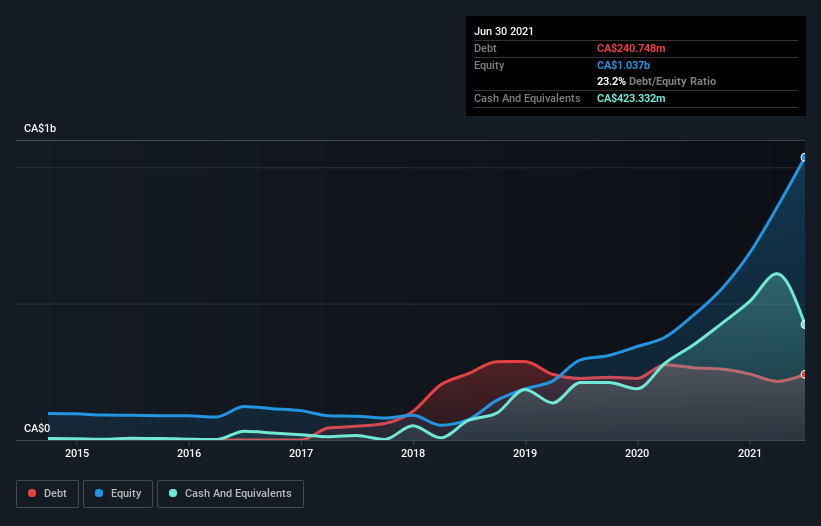Is Champion Iron (ASX:CIA) Using Too Much Debt?
Legendary fund manager Li Lu (who Charlie Munger backed) once said, 'The biggest investment risk is not the volatility of prices, but whether you will suffer a permanent loss of capital.' When we think about how risky a company is, we always like to look at its use of debt, since debt overload can lead to ruin. We note that Champion Iron Limited (ASX:CIA) does have debt on its balance sheet. But is this debt a concern to shareholders?
When Is Debt A Problem?
Generally speaking, debt only becomes a real problem when a company can't easily pay it off, either by raising capital or with its own cash flow. Part and parcel of capitalism is the process of 'creative destruction' where failed businesses are mercilessly liquidated by their bankers. However, a more usual (but still expensive) situation is where a company must dilute shareholders at a cheap share price simply to get debt under control. Of course, plenty of companies use debt to fund growth, without any negative consequences. The first step when considering a company's debt levels is to consider its cash and debt together.
View our latest analysis for Champion Iron
What Is Champion Iron's Debt?
The image below, which you can click on for greater detail, shows that Champion Iron had debt of CA$240.7m at the end of June 2021, a reduction from CA$265.3m over a year. But on the other hand it also has CA$423.3m in cash, leading to a CA$182.6m net cash position.
How Healthy Is Champion Iron's Balance Sheet?
We can see from the most recent balance sheet that Champion Iron had liabilities of CA$252.2m falling due within a year, and liabilities of CA$368.6m due beyond that. On the other hand, it had cash of CA$423.3m and CA$283.3m worth of receivables due within a year. So it can boast CA$85.9m more liquid assets than total liabilities.
This surplus suggests that Champion Iron has a conservative balance sheet, and could probably eliminate its debt without much difficulty. Succinctly put, Champion Iron boasts net cash, so it's fair to say it does not have a heavy debt load!
Even more impressive was the fact that Champion Iron grew its EBIT by 272% over twelve months. If maintained that growth will make the debt even more manageable in the years ahead. The balance sheet is clearly the area to focus on when you are analysing debt. But it is future earnings, more than anything, that will determine Champion Iron's ability to maintain a healthy balance sheet going forward. So if you want to see what the professionals think, you might find this free report on analyst profit forecasts to be interesting.
But our final consideration is also important, because a company cannot pay debt with paper profits; it needs cold hard cash. While Champion Iron has net cash on its balance sheet, it's still worth taking a look at its ability to convert earnings before interest and tax (EBIT) to free cash flow, to help us understand how quickly it is building (or eroding) that cash balance. Looking at the most recent three years, Champion Iron recorded free cash flow of 31% of its EBIT, which is weaker than we'd expect. That weak cash conversion makes it more difficult to handle indebtedness.
Summing up
While it is always sensible to investigate a company's debt, in this case Champion Iron has CA$182.6m in net cash and a decent-looking balance sheet. And it impressed us with its EBIT growth of 272% over the last year. So is Champion Iron's debt a risk? It doesn't seem so to us. There's no doubt that we learn most about debt from the balance sheet. However, not all investment risk resides within the balance sheet - far from it. Case in point: We've spotted 4 warning signs for Champion Iron you should be aware of, and 2 of them are potentially serious.
If, after all that, you're more interested in a fast growing company with a rock-solid balance sheet, then check out our list of net cash growth stocks without delay.
This article by Simply Wall St is general in nature. We provide commentary based on historical data and analyst forecasts only using an unbiased methodology and our articles are not intended to be financial advice. It does not constitute a recommendation to buy or sell any stock, and does not take account of your objectives, or your financial situation. We aim to bring you long-term focused analysis driven by fundamental data. Note that our analysis may not factor in the latest price-sensitive company announcements or qualitative material. Simply Wall St has no position in any stocks mentioned.
Have feedback on this article? Concerned about the content? Get in touch with us directly. Alternatively, email editorial-team (at) simplywallst.com.

 Yahoo Finance
Yahoo Finance 
